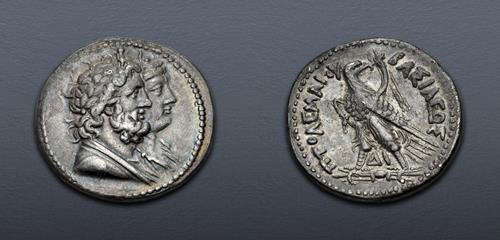|
PTOLEMAIC KINGS of EGYPT. Ptolemy IV Philopator. 222-205/4 BC. AR Tetradrachm (28mm, 13.69 g, 12h). Alexandreia mint. Struck circa 219-217 BC. Jugate draped busts right of Serapis, wearing laurel wreath with small atef crown above his forehead, and Isis, wearing grain ear wreath with miniature horned disc above her forehead / Eagle standing left, head right, on thunderbolt; filleted double cornucopia over shoulder, ΔΙ between legs. CPE 892; Svoronos 1123-4; Landvatter Group 4, 49 (O12/R39); SNG Copenhagen 197–8; BMC 7–8 (Ptolemy VI); Boston MFA 2284; Noeske 139. Old iridescent tone, light cleaning scratches. VF.
From the Mesogeios Collection. Ex Triton XXV (11 January 2022), lot 533; Renes Collection (Elsen 93, 15 September 2007), lot 411, purchased from Jean Elsen, December 1987.
This type is thought to have been issued in celebration of the Ptolemaic victory over the Seleukids at the Battle of Raphia during the Fourth Syrian War. Official propaganda proclaimed that these two deities, Serapis and Isis, had intervened on behalf of the Egyptians, saving them from defeat (see C. Lorber, “The Ptolemaic Era Coinage Revisited,” NC 2007, p. 116, and L. Bricault, “Serapis et Isis, Sauveurs de Ptolémé IV à Raphia,” Chronique d’Égypte LXXIV (1999), pp. 334-43).
Thomas Landvatter, in his die study cited above that appeared in the 2012 ANS American Journal of Numismatics (Second Series, Vol. 24, p. 88), suggests that this issue was “carrying a very specific ideological message directed more widely throughout the empire: Ptolemy IV was equating himself and his wife Arsinoe with the divine sibling-spouses Serapis and Isis.” Landvatter also notes that “[t]his was an ideological statement made during wartime, meant to have wide appeal and explicitly associate the Ptolemaic king and queen with two of the most popular deities in the Eastern Mediterranean.” Indeed, the popularity of the Serapis/Isis cult would outlive the Ptolemaic dynasty and continue well into the Roman Imperial period, only to be eventually usurped by the Christian and Muslim faiths.
Closing Date and Time: 5 June 2024 at 11:45:20 ET.
All winning bids are subject to a 20% buyer’s fee.
|
